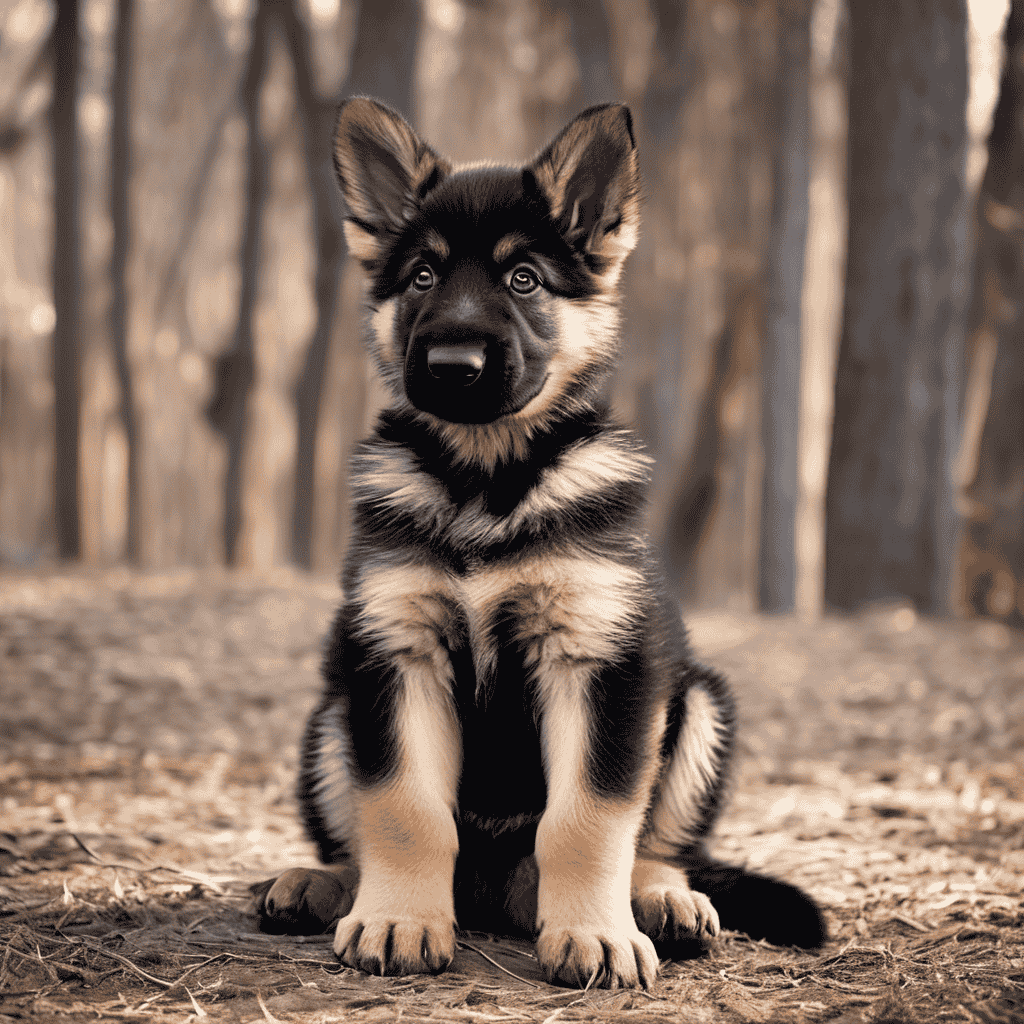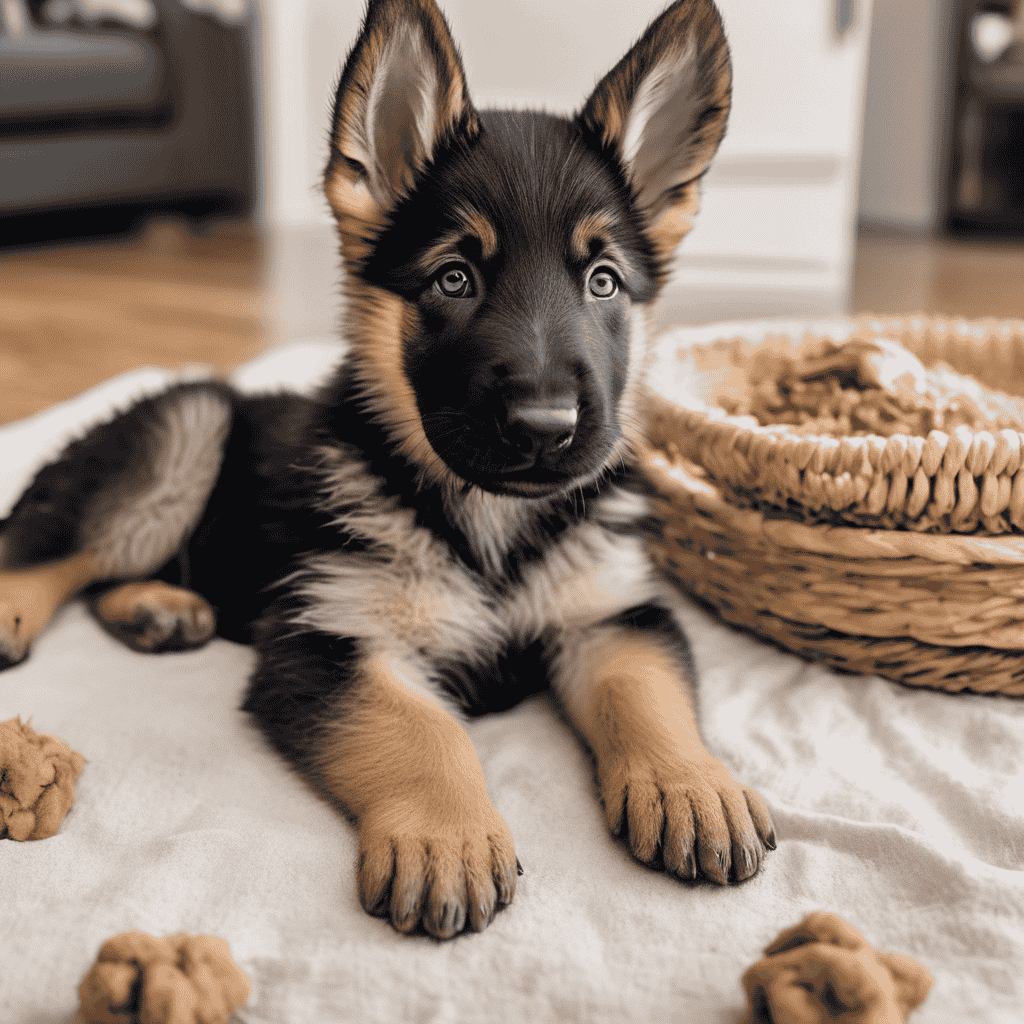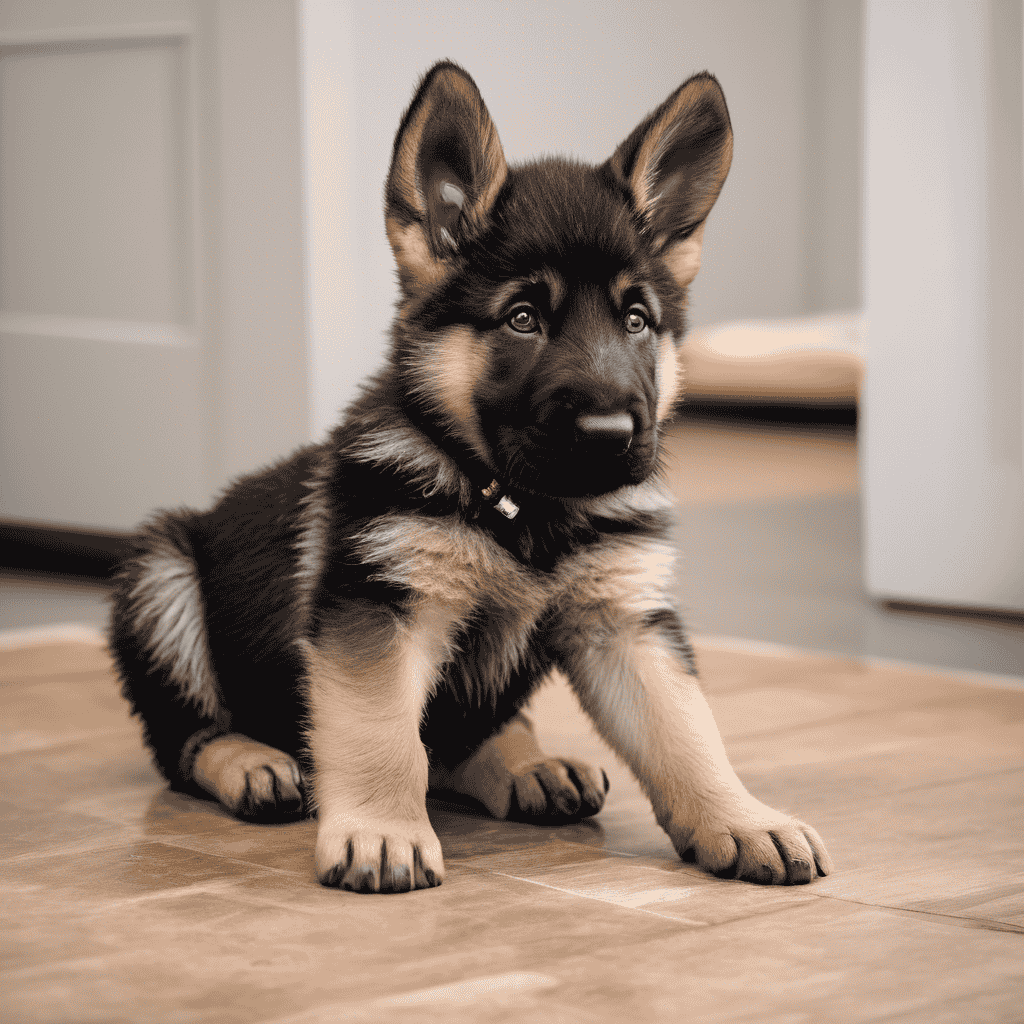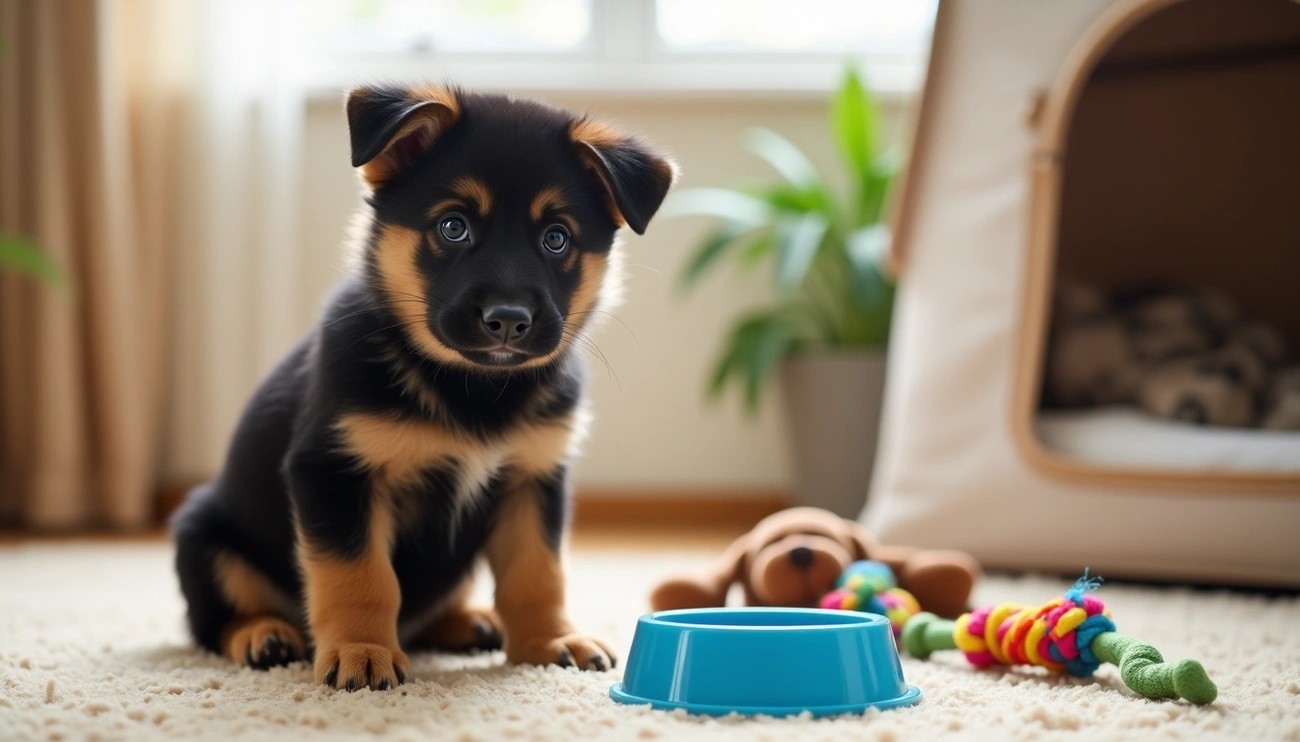Your 2-month-old German Shepherd puppy is at an exciting stage of fast growth. At this age, male puppies weigh between 16-20 pounds, while females weigh a bit less at 11-17 pounds. These lively balls of fur have already doubled their weight from last month!
During this key time, your German Shepherd puppy is set for big steps like starting potty training and getting their first shots. The eight-week mark is the best time to bring your puppy home, as they’ve started to learn key behaviors from their littermates. At this point, your puppy should eat 1-1.5 cups of top-quality puppy kibble split into 3-4 meals each day, with treats making up no more than 10% of all the food they eat. Also, your growing buddy needs lots of play time with short rounds of games like “Fetch” to help their body and mind grow.
This weekly breakdown shows you all you need to know about taking care of your 2 month old German Shepherd puppy. It covers everything from the first week’s settling-in period to setting up schedules by the fourth week. We give you hands-on tips to help your puppy grow strong, whether you’re curious about the right way to feed, train, or socialize your new pet.
Week 1: Getting Comfortable and Making First Connections
The first seven days with your 2 month old German Shepherd puppy are key for both of you to adjust. This time lets you start building your bond while you help your puppy explore its new surroundings.
Getting to know your puppy’s early actions
When your German Shepherd puppy first comes home, you might see them acting pretty calm—don’t worry! This is a time for them to get used to things, and their energy levels will be lower than they’ll be later on. It’s normal as they deal with the big change in where they live. first 24-36 hours
A lot of German Shepherd puppies have loose poop or diarrhea in their first week at their new home. This tummy trouble happens because they’re stressed from leaving their mom and brothers and sisters, plus they’re trying to get used to a new place and maybe even different food. To help their stomach feel better, you can add some cooked chicken without bones and some cooked white rice to their food if they don’t seem to want to eat much.
Helping your puppy adjust to a new home
Begin by setting up a cozy space for your puppy with the right food, water, and bed. Pick a spot where they can chill out but still be near family activities. Don’t let your puppy roam the whole house right away. Instead, show them one room at a time to avoid overwhelming them.
Before you bring your new German Shepherd home, make sure to puppy-proof. Get down on your hands and knees to find things that could harm them. Look for power cords, tiny objects they might eat, or precious items they could wreck. Keep in mind that German Shepherds are curious by nature and explore with their mouths at this age.
Set up a steady routine right away. Fixed times for eating, bathroom breaks, playing, and resting help your puppy feel safe and know what’s coming next. This regularity plays a key role in successful housetraining.
First vet visit and health check
Book your puppy’s first veterinary appointment within a few days of bringing them home. This first check lets the vet look at your puppy’s overall health and create a shot schedule that fits their specific needs.
On your first trip to the vet, they’ll give your pup a full checkup. This includes weighing them, looking at their vital signs, checking their eyes, ears, teeth, skin, and fur, and feeling their belly and lymph nodes. They’ll also check their poop to see if there are any parasites.
Remember to bring any papers you got from the breeder or shelter, a list of things you’re worried about, info on what your puppy eats, and a fresh poop sample if you can. This visit costs somewhere between $100 and $350, depending on where you live and what the vet does.
Week 2: Socialization and Early Training

As you start the second week with your 2 month old German Shepherd puppy, socializing becomes your main focus. This key time shapes how your puppy will act and feel confident later on.
Getting your puppy used to new people and noises
You should begin to socialize German Shepherds at 8 weeks and keep it up until 16 weeks. During this important growth phase, your puppy learns best from new things. Show your puppy different people, places, textures, and sounds bit by bit in a safe good way.
Begin with small steps by having 1-2 friends visit your home instead of overwhelming your puppy with large groups. Then, introduce people of varying ages, looks, and backgrounds. Also expose your puppy to common household noises like the vacuum, doorbell, and TV at low volumes to start.
Keep in mind to praise brave inquisitive behavior and always link new experiences with treats or praise to build positive connections.
Getting started with name recognition and simple commands
Teaching your puppy their name lays the groundwork for all future training. Call your puppy’s name in a cheerful, upbeat tone. When they look at you right away, mark this with a “yes” or click, then give a treat. Do this several times a day in brief 5-10 minute sessions.
After your puppy starts responding to their name, start teaching easy commands like “sit,” “down,” and “stay.” You can begin basic training for German Shepherd puppies as young as 6-7 weeks old.
Key training tips include:
- Keep sessions short (5-10 minutes at most)
- Use tasty treats to reward good behavior
- Always finish on a good note
- Never call your puppy over to scold them
Handling fear periods
Your puppy will go through their first fear period between 8-11 weeks. During this time, your brave puppy might become wary or scared of things they used to like.
When your puppy shows fear:
- Let them move away from scary things
- Don’t make them interact with scary objects or people
- Give praise and treats when they look at the scary object
- Keep training short and fun
These fear stages are normal growth steps, not signs of a bad temperament. So, if you stay patient and calm, you help your puppy get through this touchy time without many long-term effects.
Week 3: Feeding, Growth, and Teething
When your German Shepherd puppy hits week three at 2 months old, you need to pay close attention to what they eat and how they grow. This matters because they start an important growth phase and begin teething.
How much should a 2-month-old German Shepherd puppy eat?
At two months, your German Shepherd puppy needs regular meals in proper portions. Give your puppy food three times a day until they turn 6 months old. A typical 2-month-old German Shepherd weighs 16-20 pounds. Offer them about 1/2 to 1-1/2 cups of food each day, split into those three meals.
The exact amount changes based on your puppy’s weight and how active they are. A 2-month-old puppy might need around 1100 calories a day so keep an eye on their body shape and change the amount if needed. Your puppy should look slim but not too thin—you should be able to feel their ribs but not see them.
What to give a 2-month-old German Shepherd puppy to eat
Pick top-notch puppy chow made just for big dogs. This food has the right mix of calcium and phosphorus to help joints grow well and stop growth problems like hip dysplasia.
Try to find foods that list meat as the main ingredient, as this gives the protein needed for muscle growth. Also, a well-rounded diet full of protein and key nutrients helps proper growth. Many vets suggest brands such as Purina Pro Plan Focus, Hill’s Science Diet, or Blue Buffalo Life Protection Formula for large breed puppies.
Teething signs and safe chew toys
When your German Shepherd puppy reaches about 12 weeks old, they start to lose their baby teeth as adult teeth come in. This change goes on until they’re around 6 months old, at which point they should have all 42 adult teeth.
You might notice these teething signs:
- Lots of chewing or nipping
- Drooling
- Gums that look red or swollen
- Tiny blood spots on toys
- Eating more
Give your pup chew toys that are okay for teething to help their sore gums. Rubber toys, you can freeze soft chew toys, and special puppy teething rings do the trick. These toys have an impact on easing discomfort while keeping your furniture safe from those sharp puppy teeth!
Tracking your puppy’s weight and size
A 2-month-old German Shepherd usually weighs 16-20 pounds. Males tend to weigh more than females. You should weigh your puppy to make sure it grows well. Your puppy should gain weight but not become fat.
By three months, your puppy will weigh 21-31 pounds. Regular vet visits are key to tracking growth and spotting any issues.
Week 4: Play, Potty Training, and Routine Building

Week four is a crucial time to set up lasting routines with your 2-month-old German Shepherd puppy. Being consistent now will help you build good habits that will benefit your puppy for years to come.
Setting up a regular potty schedule
Potty training your German Shepherd puppy requires consistency. Take your pup outside right after they wake up, eat, play, and nap. For a 2-month-old puppy, use the month-plus-one rule—they can hold their bladder for about three hours at most.
Keep an eye out for signs that your puppy needs to go out: they might sniff the floor, wander off, get excited all of a sudden, whimper, or paw at the door. When you’re outside, use the same potty command every time, like “go potty,” and give them lots of praise when they do their business.
Don’t punish accidents—just say “uh-oh” if you catch them in the act then take them outside right away. Also, clean up messes well with enzyme cleaners to stop more accidents in the same place.
Fun games to play with your puppy
Your 2-month-old German Shepherd needs physical exercise and brain work. Fetch suits their natural prey drive, while gentle tug-of-war teaches them to control impulses. Hide-and-seek games test their problem-solving skills and strengthen your bond.
Stay away from high-impact activities like jumping that could hurt growing joints. Instead, focus on interactive games that challenge their mind. Puzzle toys with hidden treats keep them thinking even during quiet times.
Building a daily routine for meals, naps, and play
A structured daily schedule helps your German Shepherd puppy feel secure and makes training easier. Here’s an example routine:
- 6:00 AM: Get up and take puppy out to pee
- 6:30 AM: Feed breakfast, then take puppy out again
- 7:00-8:00 AM: Play and do a quick training session
- 8:00-10:00 AM: Put puppy in crate to nap
- 10:00 AM: Take puppy out and play for a bit
- 12:00 PM: Feed lunch, take puppy out, then play
Keep up this routine all day long with meals, bathroom breaks, playtime, training, and planned rest periods. For the evening schedule, give the last meal at least 2-3 hours before bedtime and take your pup out to pee right before sleep.
Crate training basics
Pick a crate big enough for your puppy to stand up, move around, and lie down. Make it cozy with comfy bedding and toys. Start by putting treats inside and leaving the door open to introduce your puppy. Then, start feeding meals in the crate to create good feelings about it.
For a 2-month-old German Shepherd, don’t keep them in the crate for more than 2-3 hours during the day. Never use the crate as punishment—your puppy should always see it as a safe space. At night, place the crate in your bedroom at first so you can hear if your puppy needs to go potty in the middle of the night.
Raising Your 2-Month-Old German Shepherd: What Lies Ahead

The first four weeks with your 2-month-old German Shepherd build key foundations for a lifelong bond. This early period shapes your puppy’s physical growth and affects their behavior and social skills. Your steady guidance during this key time helps your puppy become a self-assured, well-adjusted adult dog.
Every week brings new things to deal with and learn. In week one, you’ll focus on making your puppy feel safe and comfy in their new home. Week two starts teaching your pup how to get along with others, which stops behavior problems later on. Week three looks at what your puppy needs to eat and how they’re growing. Week four makes daily habits and training stick.
Conclusion
Keep in mind that being patient is your best tool on this journey. Your German Shepherd puppy learns by doing things over and over, getting rewards for good behavior, and following your lead. You might run into some bumps, like your German Shepherd puppy not eating well or questions about when their ears will stand up. Don’t worry – these are normal growing pains that get better with good care and attention.
Also, cheer for small wins along the way – successful potty breaks, learning a new command, or staying calm during social experiences. These little victories even if they seem small, show big steps in your puppy’s growth.
Your hard work in these early weeks builds the foundation for your German Shepherd’s physical health, emotional well-being, and behavior patterns. So, the time and effort you put in now pays off big time. You’ll end up with a balanced, happy friend for years to come. With steady care, good food, and lots of love, your 2-month-old German Shepherd will grow strong. It will become the loyal, smart companion this amazing breed is known to be.
FAQs
Q1. How much should I feed my 2-month-old German Shepherd puppy?
A 2-month-old German Shepherd puppy needs 1 to 1.5 cups of top-notch puppy food each day. Split this into 3-4 meals. Keep an eye on their body shape and tweak the amount to keep them slim but healthy.
Q2. What’s the best way to socialize my German Shepherd puppy?
To socialize your puppy, introduce them to different people, animals, noises, and places in a good way from 8 to 16 weeks old. Begin with planned meetings at home, then slowly move to new experiences. Always make sure your puppy feels safe and at ease.
Q3. How can I handle my German Shepherd puppy’s excess energy?
Mix physical exercise with brain games. Quick training, puzzle toys, and proper play work better than too much exercise. Set up a steady schedule with regular naps to avoid exhaustion.
Q4. What’s the right time to start training my German Shepherd puppy?
Start basic training when they’re about 8 weeks old. Teach them simple things like their name, “sit,” and “come.” Keep lessons short (5-10 minutes) and enjoyable. Stick to a plan and use praise to help them learn well.
Q5. How do I handle my German Shepherd puppy’s teething phase?
Give your puppy suitable chew toys to ease sore gums and shift their chewing habits. Chilled rubber toys or teething rings made for puppies can help. Keep an eye on your puppy and make your home safe to stop them from chewing and wrecking things they shouldn’t have. All 42 adult teeth.
